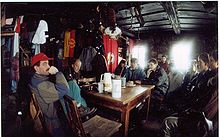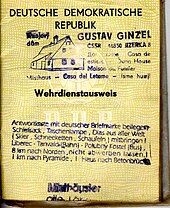Dung house
Coordinates: 50 ° 49 '28.24 " N , 15 ° 20' 18.78" O
The manure house (Czech: Hnojový Dům ) is a building made famous by Gustav Ginzel and one of the most popular excursion destinations in the Jizera Mountains in the Czech Republic . It is located in Jizerka (Klein Iser), a district of Kořenov (Wurzelsdorf).
history
The house, which was mostly made of wood, was originally built between 1699 and 1769 and is a typical Jizera mountain house. Gustav Ginzel's father was interested in the house as early as 1929, but the requested purchase price of 35,000 kroner was too high for him.
After the war the house stood empty and was initially used as a cowshed, later, when full-grown cows no longer fit in, calves and sheep followed. The outside walls had large holes and the inside was just a room with beams going through.
In 1963 the Ginzel family became interested again in the now run-down house. After some concerns about the obligations arising from the purchase of a house, Gustav Ginzel acquired the house intended for demolition on May 2, 1964 for 345 Czechoslovak crowns. The uninhabited building was filled with manure a good 3 feet high. Similar to the stable of Augias headed Ginzel a stream in the house, beräumte and sold the contents as fertilizer, which earned him more, had cost as the whole house. The stream is still used to supply the house with water.
Little by little, the house was restored and expanded both inside and out. Ginzel received the furniture as a gift from friends, and when Czechoslovak television made a film about Ginzel and the manure house, the film people had to have historic farm furniture restored as a fee, which had previously been in attics.
The manure house became a rustic place to stay without any civilizing comfort and a popular meeting place for mountaineers and hikers, but also for opposition members of the GDR and ČSSR. In the time before the fall of the Wall, the manure house was a popular excursion destination; during the holiday season, usually over 100 people a day stayed in sparsely furnished rooms for free.
The manure house has been located on the Eisenach-Budapest Friendship International Mountain Hiking Trail since 1983 , which Gustav Ginzel called the "Eisenach-Misthaus-Budapest" hiking trail.
inventory
In the house Ginzel built up a collection of souvenirs, curiosities and old books wherever he could get them cheaply or for free. He was happy to have his guests bring signs or other items. In the dung house, for example, there were large rock crystals , a Tuareg sword , Indian clothing from Peru , lava from Popocatepetl , a South American shrunken head from the Shuar , cones from sequoia trees , Tibetan prayer boards , a brick from the tower of Babylon , Saharan sand and antlers from Siberia . In the Caucasus he exchanged a remaining edition of the travel guide through Brno in Russian for antelope and ibex horns and hand-forged fireplace fittings.
- "Every better cowherd in Ossetia now has a guide to Brno."
In addition, there were curiosities, such as a molar that was pulled from him in Africa, a stuffed rattle , a duck rattle unicorn and a Wolpertinger , the negative spoon, a trapped Frenchman, as well as a plaque that said that Goethe was in the dung house during his visit to Iserwiese stayed, and this is true until proven otherwise.

The gutter in the kitchen was at a height of 30 cm so that the cat could drink from it when the water was running.
The meadows around the manure house were a sea of early bloomers in spring, as Gustav asked all of his returning guests to bring him bulbs from their homeland.
media
The first newspaper to report on the dung house was Soviet Pravda in 1966 . Countless other newspapers and magazines followed . When an article appeared on the Weltbühne in 1984 , issue 41 was sold out within a short time. In 1992 a video was shot and broadcast on Czech television on Ginzel's 62nd birthday.
Guests
Since the manure house was not a public accommodation facility, Gustav Ginzel was not allowed to collect any money for overnight stays. This handling has been checked several times by the regional authorities of the ČSSR . He could not be forbidden to take in private guests with their sleeping bags mostly under the roof ( pennant room, TV room, anti-rape room with 30 cm clear space above the "mattress") or on the upper floor (princely suite, pioneer room ) , whereby the latter rooms were sometimes reserved for well-known guests. The guests, who came mainly from the GDR , but also from the Czechoslovakia, Poland and other countries, mostly came on weekends or on public holidays and left a donation or brought donations in kind. 40 to 50 people could easily find space in the house. At the globetrotters' meetings in April and November there were significantly more people who also pitched their tents. The number of guests mostly reached their peak values over New Year's Eve, the record here was 300.
After the fall of the wall and the end of travel restrictions, the number of guests and visitors fell significantly.
guides
- "If you don't know the manure house, you've lived in vain."
The tours through the manure house were an experience. The normal tour lasted 2 hours, with laughter 3 hours. Gustav Ginzel also offered short tours (20 minutes), quick tours (10 minutes) and quick tours (5 minutes). It became clear to everyone that the supposed chaos in the house was organized according to logical criteria. After the tour, hiking maps were validated: “Every clutter needs a crap house stamp”, and he offered maps, books and calendars for sale. Gustav Ginzel was happy to emphasize that the manure house has more visitors than Friedland Castle , which is closed in winter.
Outdoor facilities
- The anti-AIDS shower is an artificial waterfall in the open air that does not freeze even at -20 ° C. Anyone who dared to do it at this temperature received a shower diploma .
- The pee stake was provided with a gutter and was used, especially in winter, to prevent men from leaving yellow ornaments in the snow.
- The stereo toilet was a lavishly signposted double latrine with a view of the Giant Mountains ridge. The toilet seat required for this was hung on a curtain rod above the stove. This had three advantages: firstly, it was easy to determine whether the place was free, secondly, the well-tempered glasses prevented the buttocks from freezing immediately in permafrost, and thirdly, everyone tried to hang them up again in a clean condition.
Fire and reconstruction
In the late evening of August 24, 1995, a fire broke out in the stereo toilet for an unknown cause , which quickly spread to the house. The five guests in the house quickly alerted the fire department. When it arrived from Jablonec nad Nisou (Gablonz), the wooden house could no longer be saved. All valuable and historical collections and curiosities, including the archive with its books and photo documentation, which were in the house, were burned. On August 31, a contact office Misthaus-Aufbau was set up in Dresden under the leadership of Jörg Puchmüller , which set up donation accounts and coordinated the start of the clean-up and reconstruction work. At that time, the host was still in Australia, but had already been informed of the accident. The establishment of further contact offices in Chemnitz , Leipzig and Berlin followed. Gustav's brother Wolfgang Ginzel took over the management of the entire campaign . On January 22, 1996, a benefit event for the manure house took place in the Bärenzwinger student club in Dresden , at which Reinhold Messner was also present. Numerous weekend helpers removed the remains and on May 11, 1996 a company from Jablonec nad Nisou began to rebuild the house based on the old model, which was completed in 1997.
In the meantime, the interior of the house has also been redesigned with new exhibits.
Since 2000 the visit has only been possible to a limited extent due to illness of the landlord. Wolfgang Ginzel managed the manure house until he died in the spring of 2004. Since then the manure house has been closed due to illness . Gustav Ginzel lived with his sister in Kempten , Germany , until his death in 2008 .
Known guests
- Heinz Eggert , former Saxon interior minister
- Ibrahim Boehme
- Lothar de Maizière
- Vaclav Havel
- Karol Wojtyła
literature
- Gustav Ginzel: The manure house story
- Matthias Elstner: My little world, ISBN 3-86548-684-3 .
- Bernd Raffelt: Misthausgeschichten, ISBN 3-00-020366-4 .







